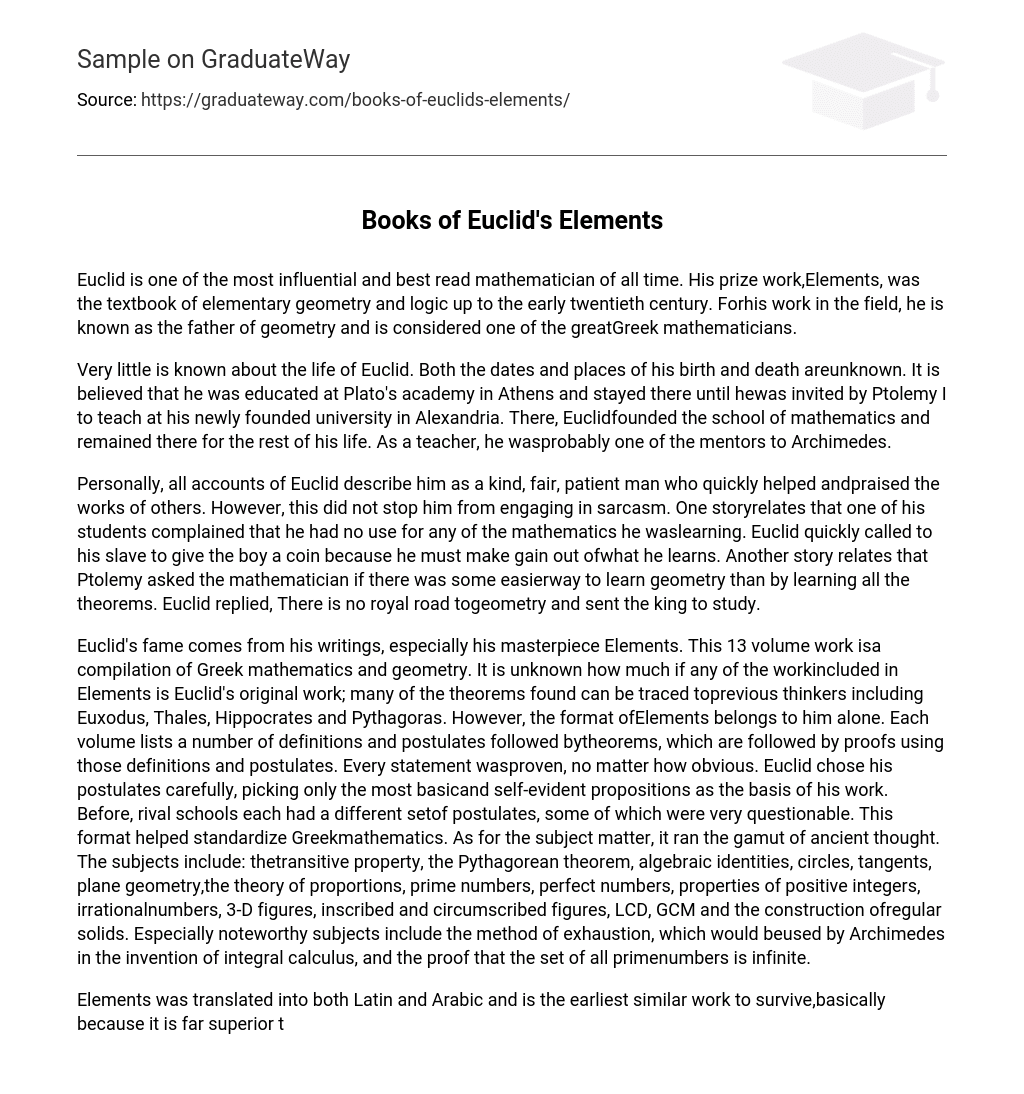Euclid, also referred to as the father of geometry, is highly acclaimed for his significant contributions and extensive studies in mathematics. His well-known masterpiece, Elements, played a crucial role as a fundamental educational resource for geometry and logic until the early 1900s. Euclid’s exceptional reputation places him among the esteemed Greek mathematicians of his time.
Euclid’s birth and death details are unknown, but it is believed that he was educated at Plato’s Academy in Athens. Later, he was invited by Ptolemy I to teach at the newly established university in Alexandria. In Alexandria, Euclid founded the school of mathematics and spent the rest of his life there. It is likely that he mentored Archimedes during his time as a teacher.
Euclid is often described as a kind, fair, and patient man who frequently offered assistance and praise to others’ works. However, he also used sarcasm. For instance, one story recounts a student’s complaint about the usefulness of his mathematics studies. In response, Euclid promptly called for his slave to give the boy a coin, implying that he should profit monetarily from his education. Another anecdote involves Ptolemy’s inquiry about an easier way to comprehend geometry without studying all the theorems. Euclid replied by stating “There is no royal road to geometry” and advised the king to continue his studies.
Euclid gained renown for his writings, particularly his significant piece known as Elements. This compilation, consisting of 13 volumes, encompasses Greek mathematics and geometry. The extent to which Elements comprises Euclid’s own original contributions remains uncertain. Numerous theorems featured in this compilation can be attributed to earlier intellectuals including Euxodus, Thales, Hippocrates, and Pythagoras.
Euclid’s Elements has a unique format that sets it apart. Each volume contains definitions and postulates, followed by theorems proven using those definitions and postulates. Every statement is meticulously proven, even if it appears obvious. Euclid carefully chose fundamental and self-evident propositions as the foundation of his work, unlike rival schools with questionable postulates. This format established a standardized framework for Greek mathematics and covers various ancient thoughts.
The topics covered in the text include:
the transitive property, the Pythagorean theorem, algebraic identities, circles, tangents, plane geometry, the theory of proportions, prime numbers, perfect numbers, properties of positive integers, irrational numbers, 3-D figures, inscribed and circumscribed figures, LCD, GCM, and the construction of regular solids.
Of particular importance are the method of exhaustion, which Archimedes would later utilize in the invention of integral calculus, and the proof that there is an infinite set of all prime numbers.
Elements is the earliest surviving similar work that was translated into both Latin and Arabic. It is considered far superior to any previous works. The first printed copy was released in 1482 and became a widely used textbook for geometry and logic by the 1700s. Euclid, highly respected as a mathematician during this period, authored many other works including Data, On Division, Phaenomena, Optics, and the lost books Conics and Porisms. Elements was regarded as one of the greatest mathematical works of all time and continued to be used in schools up until 1903.
Today, Euclid’s once revered status has diminished significantly. During his lifetime, he faced criticism from fellow mathematicians who believed he was overly meticulous and included obvious proofs, such as the well-known fact that one side of a triangle cannot exceed the sum of the other two sides. However, in present times, most mathematicians critique Euclid for the opposite reason: his lack of thoroughness. Elements, Euclid’s renowned work, contains gaps that subsequent mathematicians were compelled to complete.
In addition, there have been several errors and questionable ideas discovered, with the most glaring one pertaining to Euclid’s fifth postulate, also known as the parallel postulate. This proposition maintains that for a straight line and a point not on the line, there exists exactly one line that passes through the point parallel to the original line. Euclid was unable to prove this statement and, as he needed it for his proofs, he assumed it to be true. However, future mathematicians were unable to accept that such a statement was unprovable and spent centuries searching for an answer. It was only with the arrival of non-Euclidean geometry, which replaces the statement with postulates that assume different numbers of parallel lines, that the statement has been generally accepted as necessary.
However, despite the mentioned problems, Euclid is noteworthy for being among the first individuals to endeavor in the standardization of mathematics and establishing it on a basis of proofs. His contributions served as a starting point for future generations.





